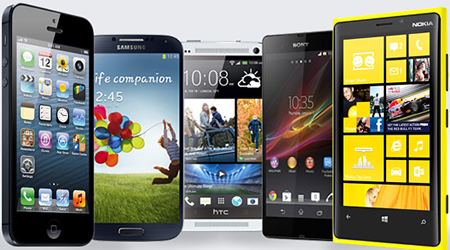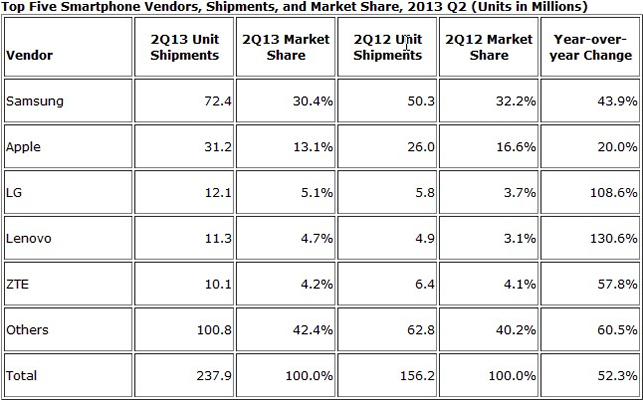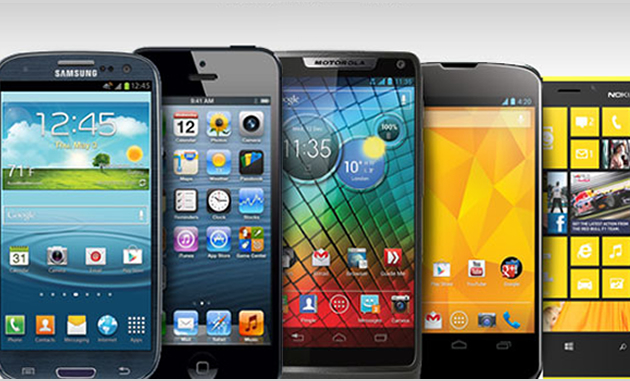Samsung took a bite out of Apple in recent months, overtaking the iPhone in worldwide profits for smartphone sales for the first time. The two companies have been running neck-and-neck for years now in the endless race for world smartphone domination.
 Samsung became the world’s most profitable handset vendor in Q2 2013, while Apple slipped to second place, due largely to lackluster iPhone 5 volumes and tougher competition in China, according to a new report released this week from Strategy Analytics. The research firm estimates that Samsung’s operating profit for its handset division stood at US$5.2 billion in the second quarter of 2013, while Apple recorded an estimated iPhone operating profit of US$4.6 billion.
Samsung became the world’s most profitable handset vendor in Q2 2013, while Apple slipped to second place, due largely to lackluster iPhone 5 volumes and tougher competition in China, according to a new report released this week from Strategy Analytics. The research firm estimates that Samsung’s operating profit for its handset division stood at US$5.2 billion in the second quarter of 2013, while Apple recorded an estimated iPhone operating profit of US$4.6 billion.
“With strong volumes, high wholesale prices and tight cost controls, Samsung has finally succeeded in becoming the handset industry’s largest and most profitable vendor,” says Neil Shah, Strategy Analytics Senior Analyst.
Apple shipped 31.2 million iPhones last quarter, according to another report just released by research firm IDC. Although that number is down from previous quarters, its still impressive considering that the iPhone 5 has been in the market now for three quarters, and has still sold relatively well despite competition from the popular Samsung Galaxy S4 and HTC One Android phones.
Apple began its reign as the world’s most profitable handset vendor back in late 2009, but recently the company has seen fading profit margins for its handset division due to lackluster iPhone 5 volumes and tougher competition from rivals such as Samsung, HTC, LG, Motorola, and even Nokia. Samsung is Apple’s toughest competitor in the US market, while Huawei, ZTE and other local brands are growing vigorously in China.
“Apple is now under intense pressure to launch more iPhone models at cheaper price-points or with larger screens to fend off the surging competition and recapture lost profits in the second half of 2013,” notes Neil Mawston, Executive Director at Strategy Analytics.
Apple is expected to announce the iPhone 5S and possibly a lower-cost iPhone “5C” at an event on September 10th.
Worldwide mobile market continues to surge
According to IDC, the worldwide mobile phone market grew 6 percent year over year in the second quarter of 2013 (2Q13), with vendors shipping a total of 432.1 million mobile phones that quarter compared to 407.7 million phones in the same quarter of 2012, according to IDC’s Worldwide Quarterly Mobile Phone Tracker report. The 2Q13 total was also slightly higher than the 428.8 million units shipped in the first quarter of 2013.
The growth in the mobile phone market was partly driven by vendors from outside the top five players, who experienced a surge in shipments that outpaced the overall market, says IDC. Several vendors, including Alcatel and Huawei, had high double- and triple-digit growth rates in the second quarter for their Android-based offerings shipped to high-growth countries such as China and India. In 2Q13, these vendors from outside the Top 5 accounted for 44.8% of the overall shipment volume, up from 42.2% in the same quarter one year ago.
In the worldwide smartphone market, vendors shipped 237.9 million units in 2Q13 compared to the 156.2 million units shipped in 2Q12. This represents 52.3% year-over-year-growth, the highest annual growth rate in five quarters. Second quarter shipments were up 10.0% when compared to the 216.3 million units shipped in 1Q13.
“Market opportunities exist at all levels, including the high end,” says Ramon Llamas, Research Manager with IDC’s Mobile Phone team. “While Samsung and Apple accounted for significant share of the overall market, they were not the only vendors active in the high end of the market, and recent device introductions and upcoming launches signal more vendors targeting this space. Comparisons will certainly be made to the flagship Galaxy and iPhone models, but clearly the competition refuses to be shut out altogether.
“The opposite end of the spectrum is just as, if not more, interesting,” adds Kevin Restivo, IDC Senior Research Analyst. “Lower-priced smartphones continue to gain traction, but the key for vendors will be to keep prices low while still offering premium devices and services. We fully expect to see large-screen smartphones and other flagship devices establish a presence within the lower-priced smartphone segment as well.”
Apple’s top competitors each gain market share
Samsung, on the heels of its Galaxy S4 launch during the quarter, saw its volumes reach new levels and accounted for nearly a third of the entire smartphone market. Not to be overlooked is the continued success of its Galaxy S III smartphones, which saw renewed interest following discounted prices in advance of the Galaxy S4 launch. By the end of the quarter, Samsung more than doubled the total volumes of the next largest vendor, and shipped more units than the next four vendors combined.
LG sustained its momentum from the first quarter of 2013 with total shipments more than double the volume from a year ago for the second consecutive quarter and staying slightly ahead of the competition to retain the number 3 position. More importantly, the company realized a profit from its steady diet of Android-powered smartphones, a feat that very few Android vendors have been able to realize. Now that LG has reinvigorated its product portfolio with the Nexus 4 and the Optimus G Pro, the company is aiming to branch out further into the high end with its upcoming G2, and into the mass market with its L-Series II and F-Series smartphones.
Lenovo returned to the smartphone Top 5 after a two-quarter absence, reaching double-digit shipments in the process. Its volume for the quarter was driven in large part by shipments to 3G operators in China where it is based. A variety of its LePhone brand family phones, such as the A728t, were among its popular models last quarter. Lenovo hopes to build on its recent success with international diversification efforts that will lead it to regions like Latin America in coming quarters.
ZTE finished among the smartphone leaders for the fourth straight quarter thanks to its success in the Asia/Pacific region. ZTE hopes to remain a smartphone stalwart, which is why it has set a goal of 50 million smartphone shipments this year. The company is trying to reach its goal in part by selling 11 LTE-enabled smartphones. Also, ZTE is selling higher-cost products in a wider variety of countries including India where it recently launched six new smartphones, such as the Grand X, this month.

You can get the IDC’s latest Worldwide Quarterly Mobile Phone Tracker report here. For Strategy Analytics’ full report, “Samsung Becomes World’s Most Profitable Handset Vendor in Q2 2013,” see here.





